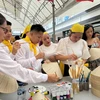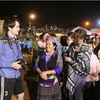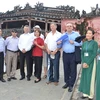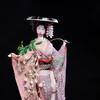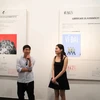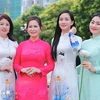A spiritual and cultural space has opened at the Vietnamese Women's Museum to help people understand more about Mother Goddesses worship, a Vietnamese folk belief with a long history which has adapted to social changes.
Today this belief is widely practised throughout Vietnam and in Vietnamese communities overseas. The exhibition features an altar of Mother Goddesses, the related rites and the position of this belief among Vietnamese people.
Worship of the Mother Goddesses address the concern of daily life and desires for good health and good fortune. Worshippers find great emotional support in their belief and it attracts followers from all parts of society, said Nguyen Thi Bich Van, the museum's director.
Key values of Mother Goddesses worship are introduced through the voices and experiences of worshippers in Hanoi and northern provinces to give visitors a better understanding of the typical Vietnamese folk beliefs.
The exhibition is divided into four sections: the Mother Goddesses, Pure Heart, Joy and Beauty. Each section corresponds to one of four colours identified with the four palaces of the Mother Goddesses religion: Red as Palace of Heaven , White as Palace of Water , Yellow as Palace of Earth and Green as Palace of Mountains and Forests. Each Mother Goddess controls one palace with support from many gods and heroes.
Visitors are sure to be impressed with the exhibition's portrayal of the “hau dong” (mediumship) ritual involving the sophisticated mixture of colours symbolising the Four Palaces , “chau van” (spiritual singing) and the sacred principles involved in arranging the altars, offerings, costumes and jewellery.
A moving aspect of the exhibit will offer visitors a glimpse of a recreated sacred space paying tribute to the Mother Goddesses, who worshipers believe protect and support them in overcoming difficulties and misfortunes. Pure Heart is expressed through the respect and belief of the people. They follow Mother Goddesses, do good things, remember their ancestors, and seek good health and prosperity.
"It's expected that through the exhibition, people will understand the cultural value of the Mother Goddesses belief," said Dr Nguyen Van Huy, former director of the Vietnam Museum of Ethnology.
Laurel Kendall, a researcher from the US who helped organise the exhibition, said the hau dong ritual was a type of performing art in which the medium wears beautiful costumes and jewellery, dances and tells stories of the gods and heroes through “chau van” music.
"The Beauty subject of the exhibition reflects the beautiful performances found in Mother Goddesses worship," she said.
"Each god has his/her own story and appearance so the medium changes costumes and movements flexibly. That performance becomes a beautiful visual art to attract the audience."
The interaction between the medium, spectators and musicians in the ritual space generates an accelerating sense of joy until the ecstatic participants are able to forget all the sorrow of their daily life.
This sense of joy grows when spectators receive “loc” (god's spiritual and material favour), including the fruit and flowers used to worship, which is distributed to spectators when the ritual is over.
The Vietnamese Women's Union began research for this temporary exhibit in 2009 with sponsorship from the Ford Foundation and the Centre for Research, Support and Development of Culture.
Kendall has attended many “hau dong” rituals and learnt much more about the Mother Goddesses belief in Vietnam . She expects that the exhibition will help both Vietnamese and foreign people understand the belief's values through presentation in Vietnamese, French and English. A film screening typical “hau dong” performances is being shown adjacent to the showroom.
The exhibition is on-going at the Vietnamese Women's Museum, 36 Ly Thuong Kiet Street , Hanoi. /.
Today this belief is widely practised throughout Vietnam and in Vietnamese communities overseas. The exhibition features an altar of Mother Goddesses, the related rites and the position of this belief among Vietnamese people.
Worship of the Mother Goddesses address the concern of daily life and desires for good health and good fortune. Worshippers find great emotional support in their belief and it attracts followers from all parts of society, said Nguyen Thi Bich Van, the museum's director.
Key values of Mother Goddesses worship are introduced through the voices and experiences of worshippers in Hanoi and northern provinces to give visitors a better understanding of the typical Vietnamese folk beliefs.
The exhibition is divided into four sections: the Mother Goddesses, Pure Heart, Joy and Beauty. Each section corresponds to one of four colours identified with the four palaces of the Mother Goddesses religion: Red as Palace of Heaven , White as Palace of Water , Yellow as Palace of Earth and Green as Palace of Mountains and Forests. Each Mother Goddess controls one palace with support from many gods and heroes.
Visitors are sure to be impressed with the exhibition's portrayal of the “hau dong” (mediumship) ritual involving the sophisticated mixture of colours symbolising the Four Palaces , “chau van” (spiritual singing) and the sacred principles involved in arranging the altars, offerings, costumes and jewellery.
A moving aspect of the exhibit will offer visitors a glimpse of a recreated sacred space paying tribute to the Mother Goddesses, who worshipers believe protect and support them in overcoming difficulties and misfortunes. Pure Heart is expressed through the respect and belief of the people. They follow Mother Goddesses, do good things, remember their ancestors, and seek good health and prosperity.
"It's expected that through the exhibition, people will understand the cultural value of the Mother Goddesses belief," said Dr Nguyen Van Huy, former director of the Vietnam Museum of Ethnology.
Laurel Kendall, a researcher from the US who helped organise the exhibition, said the hau dong ritual was a type of performing art in which the medium wears beautiful costumes and jewellery, dances and tells stories of the gods and heroes through “chau van” music.
"The Beauty subject of the exhibition reflects the beautiful performances found in Mother Goddesses worship," she said.
"Each god has his/her own story and appearance so the medium changes costumes and movements flexibly. That performance becomes a beautiful visual art to attract the audience."
The interaction between the medium, spectators and musicians in the ritual space generates an accelerating sense of joy until the ecstatic participants are able to forget all the sorrow of their daily life.
This sense of joy grows when spectators receive “loc” (god's spiritual and material favour), including the fruit and flowers used to worship, which is distributed to spectators when the ritual is over.
The Vietnamese Women's Union began research for this temporary exhibit in 2009 with sponsorship from the Ford Foundation and the Centre for Research, Support and Development of Culture.
Kendall has attended many “hau dong” rituals and learnt much more about the Mother Goddesses belief in Vietnam . She expects that the exhibition will help both Vietnamese and foreign people understand the belief's values through presentation in Vietnamese, French and English. A film screening typical “hau dong” performances is being shown adjacent to the showroom.
The exhibition is on-going at the Vietnamese Women's Museum, 36 Ly Thuong Kiet Street , Hanoi. /.





